

How mammals won the dinosaurs' world - BBC Future
source link: https://www.bbc.com/future/article/20220812-dinosaur-extinction-why-did-mammals-survive
Go to the source link to view the article. You can view the picture content, updated content and better typesetting reading experience. If the link is broken, please click the button below to view the snapshot at that time.
How mammals won the dinosaurs' world
Article continues below
Through darkness, ash and deadly heat, a tiny furry animal scurries through the hellscape left behind by the worst day for living things in Earth's history. It picks through the wreckage, snatches an insect to eat, and scuttles back to its shelter. All around it are the dead and dying bodies of the dinosaurs that have terrorised mammals for generations.
These were the early weeks and months after a six-mile-wide (10km) asteroid collided with the coast of present-day Mexico with the force of more than a billion nuclear bombs, ending the Cretaceous spectacularly. At the dawn of the era that followed, the Paleocene, the forests were on fire, tsunamis rocked the coasts, and vast quantities of vaporised rock, ash and dust were rising miles into the atmosphere.
But this world was not devoid of life. Among the survivors was the earliest known primate, Purgatorius, which looked like a cross between a shrew and a tiny squirrel. Its numbers would surely have dwindled amid this global catastrophe, but the species survived.
Such was the life of early mammals soon after the asteroid hit and extinguished three-quarters of the Earth's living species. Only the Great Dying, 252 million years ago, was more deadly (though less sudden), killing 95% of life in the oceans and 70% of that on land.
How was it that this miscellaneous group of small and vulnerable creatures – including our ancestors – survived doomsday?
The asteroid that ended the Cretaceous took with it famous dinosaurs like Tyrannosaurus and Triceratops, as well as lesser-known but bizarre creatures like Anzu, or the "chicken from hell". There were duck-billed dinosaurs, long-necked dinosaurs, dinosaurs with armour all over their bodies – and, very quickly, all of them were dead.
In the shadow of these kings and queens of the Late Cretaceous, mammals like Purgatorius were small and scrappy, many of them filling the kinds of ecological niches today occupied by rodents. How was it that this miscellaneous group of seemingly vulnerable creatures – including our ancestors – survived doomsday?
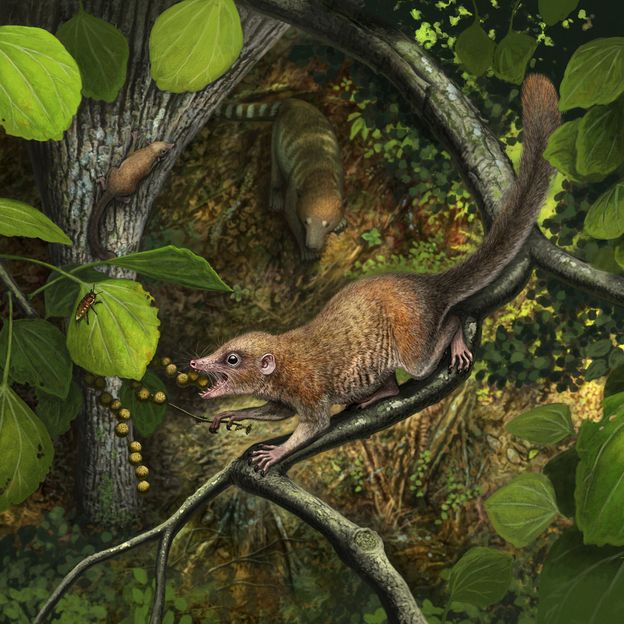
Purgatorius, the earliest known primate, is thought to have been among the asteroid survivors (Credit: Andrey Atuchin)
It's a question that Steve Brusatte, author of The Rise and Reign of the Mammals, and his colleagues at the University of Edinburgh have been working to unpick.
One thing Brusatte stresses is that the day the asteroid hit was a very bad day to be alive for anything, including mammals, birds (the avian dinosaurs) and reptiles. "This was no normal asteroid, this was the biggest asteroid that's hit the Earth in at least the last half a billion years," says Brusatte. "Mammals almost went the way of the dinosaurs."
There was a lot to lose. Already in the Late Cretaceous there was a surprisingly rich diversity of mammals, says Sarah Shelley, a postdoctoral researcher in mammal palaeontology at Edinburgh. "A lot of them were these insectivorous little things that were up in the trees or burrowing," says Shelley.
Not all were insect-eaters, though. There were the mysterious multituberculates, so called for the peculiar nodules on their teeth. "They've got these blocky teeth with lots of nubbins on them, and the front was a blade-like tooth. It looks like a saw almost," says Shelley. "They're eating fruits, nuts and seeds."
There were carnivores too – one of the largest of the time was Didelphodon, a marsupial relative weighing around 5kg (11lb), about the size of a domestic cat. "From its skull and dental anatomy it had a really powerful bite, so it's definitely carnivorous – possibly crunching bones," says Shelley.
Much of this diversity was lost when the asteroid hit – around nine in 10 mammal species died out, according to Brusatte, which brought an unprecedented opportunity for the survivors.
"Just imagine you're one of these tiny little ancestors of ours, the size of a mouse – a small little meek thing hiding in the shadows – and you endure this moment of Earth's history," says Brusatte. "You come out on the other side, and all of a sudden the T. rexes are gone and the long-necked dinosaurs are gone, and the world is open."
This mass extinction set the stage for a great profusion of diversification that eventually brought about blue whales, cheetahs, dormice, platypus and, of course, us.
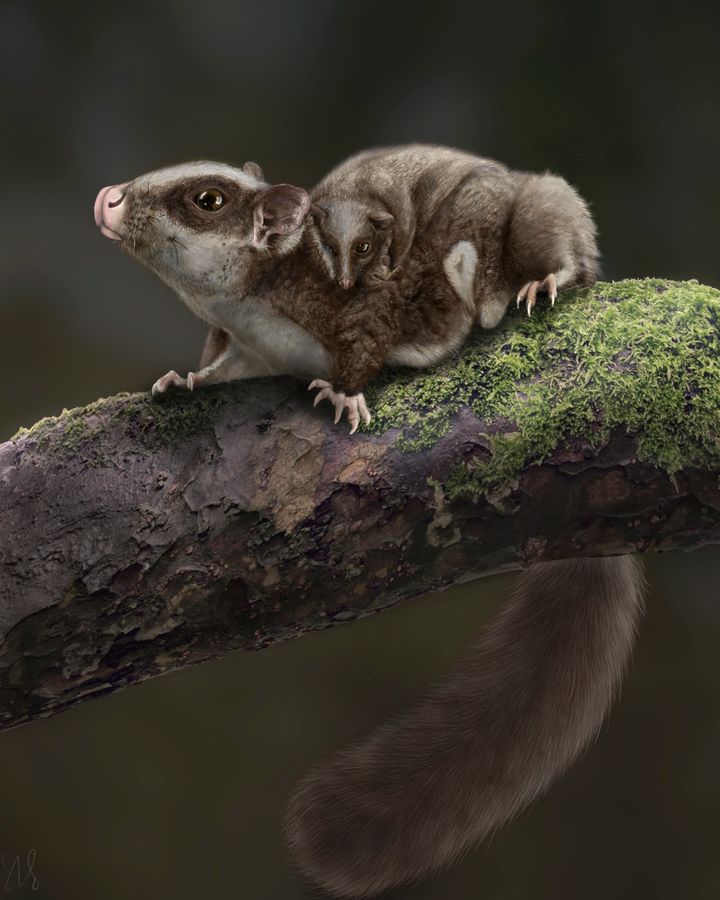
Mammals lived alongside dinosaurs for aeons, and were generally small – such as the tiny gliding Vilevolodon, which lived in the Jurassic (Credit: Sarah Shelley)
First, though, a small hitch: the world's forests had been obliterated by wildfire and the sky was full of ash, choking out sunlight and preventing plants from photosynthesising. Ecosystems were collapsing "like houses of cards", as Brusatte puts it. The surface of the Earth was set to become hotter than an oven in a vicious rollercoaster of heat pulses and after that, a nuclear winter in which average temperatures would drop by 20C (36F) for more than 30 years. Many of the mammals' most dangerous predators had gone, but the world itself had become unimaginably hostile to life.
So what did mammals do?
Stay small
Mammals' modest body sizes – previously constrained by dinosaur competition and predation – became an asset for the "disaster fauna", as the asteroid survivors are known.
"These mammals were probably things that looked and acted something like a mouse or a rat," says Brusatte. "Normally they would be pretty anonymous but now, in this brave new world, they were proliferating because they were so well suited to those really nightmarish conditions right after the impact."
Being small may have helped animals to replenish their numbers. In modern animals, "the bigger the animal is, the longer the gestation time is going to be", says Ornella Bertrand, a postdoctoral researcher in mammal palaeontology at the University of Edinburgh. For instance, the African elephant gestates for 22 months, whereas a mouse's pregnancy lasts around 20 days. Faced with the apocalypse, the mouse has the better odds of keeping its population up.
You might also like:
Besides gestation, a larger body typically takes longer to reach sexual maturity – another reason dinosaurs didn't make it, especially the larger ones. "It took them quite a while to grow into an adult. For something like T. rex it took about 20 years," says Brusatte. "It's not that they didn't grow fast, it's just that so many of them were so big that it took them a long time to go from a tiny little hatchling into an adult."
Get underground
Another hint at how mammals survived the aftermath of the asteroid comes from the "very weird" body shapes seen in the Paleocene and beyond. Shelley analysed ankle bones (small, tough, dense bones that preserve well) to see how similar early Paleocene mammals were to each other, and to mammals alive today.
"We found that the Paleocene mammals are weird. They are different from modern mammals," Shelley says. "And what unites them is the fact they've got these really chunky, robust morphologies."
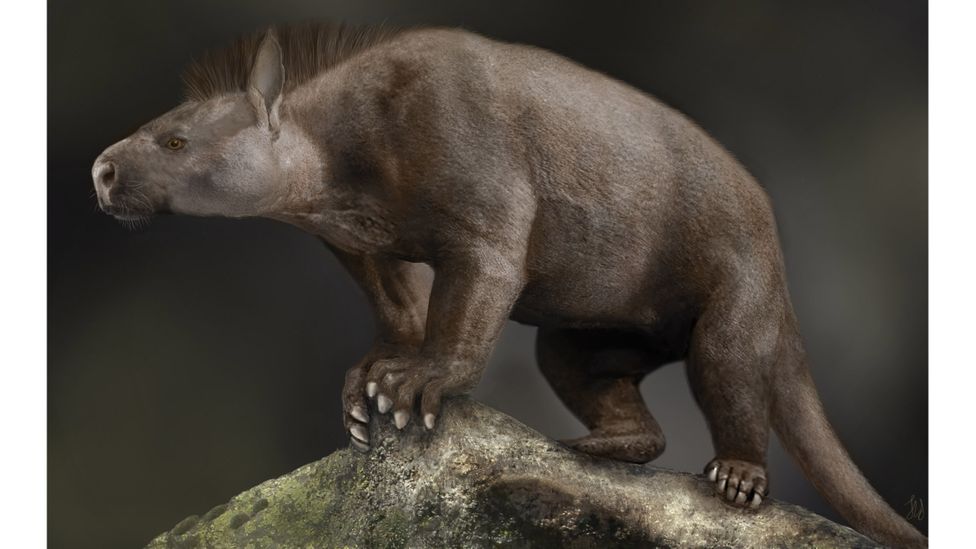
Periptychus, which may be related to living pigs, cows and sheep, was part of a group that grew large and brawny after the end of the dinosaurs (Credit: Sarah Shelley)
These mammals have large muscle attachments and generally hefty bones, and among living animals they have the greatest similarity to ground-dwelling and burrowing species, says Shelley. "So the hypothesis that came out of this was the animals that survived the extinction preferentially survived because they were able to dig to get underground, survive that immediate impact period and the fires, the nuclear winter, and just hunker down for a bit."
Because the survivors were – there's no other way to put it – hench, their descendants too inherited their robust body shape. "You can see it for that 10-million-year period during the Paleocene," says Shelley. "Even if you're an animal that is living in trees, they're still really chunky."
If mammals did indeed take to life underground, either by burrowing themselves or making use of others' subterranean shelters, Bertrand suspects this might be reflected in their agility too – or lack of it. "We know that there was a collapse of the forest and so all those animals living in trees didn't have a habitat anymore," she says. "And so, one of the hypotheses would be that there were fewer animals able to engage in very agile behaviour."
Bertrand plans to investigate the inner ear bones of mammals of this era to see whether they back up the idea of an underground turn after the asteroid. The inner ear is crucial for balance, so if an animal is adapted to make finely tuned, agile movements this is sometimes reflected in the structure of these delicate bones. However, if they were burly diggers, such agility would not have been necessary. "It could give us more clues," she says. That said, she points out the drawbacks of relying too heavily on bones to infer how an animal moved around, something that struck her while watching the recent Commonwealth Games.
"I was watching the gymnasts doing crazy things and I was like, that's funny – we have the same skeleton and I can't do any of that," Bertrand laughs. "I thought, well, that's really interesting because maybe having that capability can help you survive, but from the bones you wouldn't know."
Eat anything
The asteroid destroyed most living plants, the first link of many food chains on land. Generalist mammals with the ability to turn their palates to anything going did better than those with more particular diets.
"The animals that got through the extinction survived basically just by not being too specialised," says Shelley. For instance, the Didelphodon (the cat-sized carnivorous marsupial relative) preyed on animals that were few and far between after the extinction. "It specialised too much and lost its niche," says Shelley. "Whereas if you're a small animal you can adapt your diet and your lifestyle more rapidly. That's a good way to survive the extinction."
As well as those that could generalise, there were a few specialisms that would have done well, says Brusatte. In particular, seed-eaters were in luck. "Seeds were a food bank that was just there available to any animal that already had the capacity to eat them," he says. "So if you were something like a T. rex you were out of luck, evolution did not bestow you with the ability to eat seeds. But for birds with beaks and some mammals who were specialised seed eaters then whoa, what kind of good turn of fate is that?"
Beyond sustaining the disaster fauna, seeds helped re-establish forests and other vegetation when the nuclear winter faded. "Those seeds survived in the soil and then, when the sunlight came down again those seeds started to grow," says Brusatte.
Don't overthink
As the Paleocene wore on, ecosystems recovered and mammals began to fill the niches left empty by the non-avian dinosaurs. "Mammals started to diversify right away after the dinosaurs went extinct, and they started to become very diverse in every possible way," says Bertrand.
For one thing, bodies got larger quickly. But for a time, the Edinburgh team have found, the the size of mammals' brains didn't keep pace.
"I think that's very important, because we might think intelligence is what makes us survive and be so able to dominate the planet," says Bertrand. "But, from the data it's not large brains that made animals survive after the asteroid."
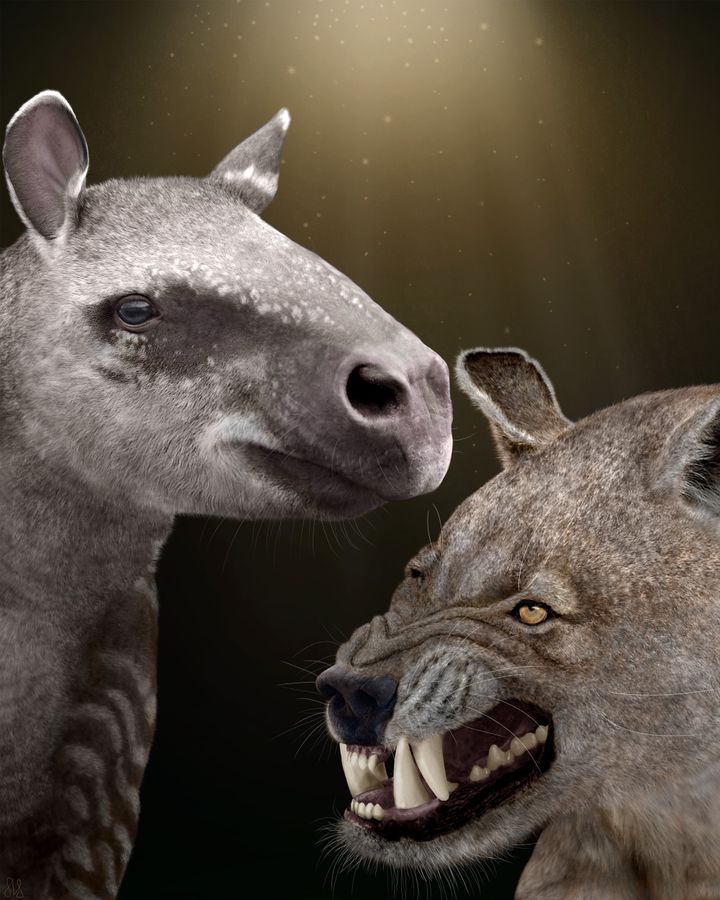
Large herbivores like Hyrachyus, left, and large carnivores like Arctocyon, right, evolved after the dinosaurs died (Credit: Sarah Shelley)
In fact, in the early Paleocene mammals with large brains relative to their body size may have been at a disadvantage. "The question is why would you grow a big brain?" Bertrand asks. "A large brain is actually expensive to maintain. If you have a big brain you need to feed it to be able to maintain it – if you can't because there is not enough food, you'll die out."
Instead, getting large and brawny was the favourable adaptation. The herbivore Ectoconus (a member of the Periptychidae, which may be related to living hoofed mammals, the ungulates) reached about 100kg (220lb) within a few hundred thousand years of the extinction. In geological time, that's the blink of an eye. "It's mad really that they're getting that big that quickly and specialising that quickly," says Shelley. "And you see, once you get larger herbivores there are larger carnivores, and they start popping up pretty quickly."
There are many other mysterious mammals that swelled in size rapidly too. "Things like taeniodonts – they got big really quickly, really big," says Shelley. There are no complete skeletons of the taeniodonts but the skull is around the size of a large butternut squash, and they appear to be one of those species that became chunky and adapted for digging. "It's got these teeny-tiny spaces for these beady little eyes, massive teeth at the front, which kind of bear resemblance to rodents, but that's about it," says Shelley. "They're really enigmatic."
This swift menagerie of mammalian life that followed on from the disaster fauna has been overlooked for too long, says Shelley. "They've been called archaic and primitive and generalised – whereas actually no, they're just different," she says. "Their ancestors survived the second biggest mass extinction in the history of life. They weren't just generalised morons who ambled their way through life. They were surviving and thriving and doing it really well."
In many ways, these mammals were stepping into the ecological voids left by the magnificent, hyper-specialised dinosaurs so well-suited to the Late Cretaceous, but so profoundly poorly equipped to deal with an asteroid-struck world.
"It's astounding to think that you had a group like dinosaurs that had been around for so many tens of millions of years, that had done such sublime things as evolve into giants the size of airplanes, and meat-eaters the size of buses and all these things – and then it all came crashing down in an instant when the Earth changed so quickly," says Brusatte. "They were just so ill-suited to that new reality and they couldn't adapt."
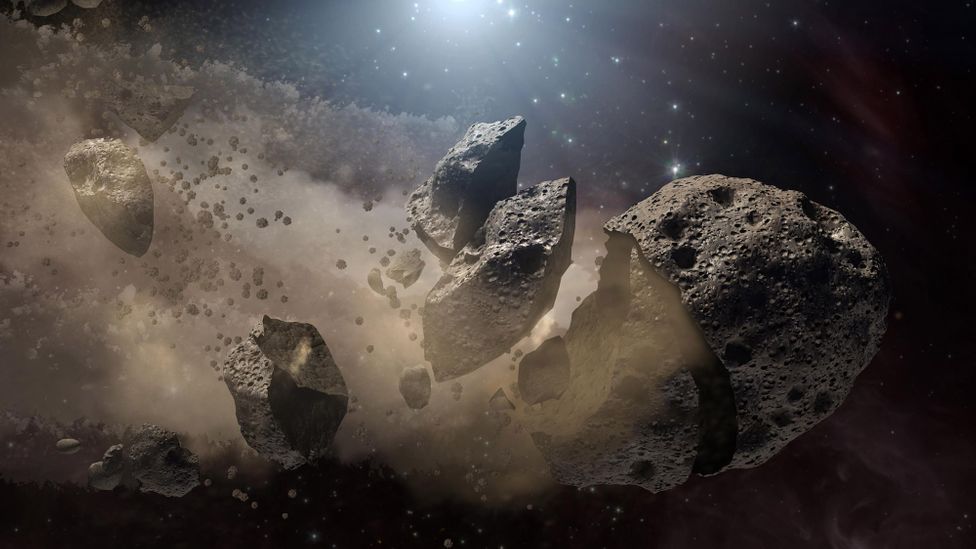
The asteroid that killed the dinosaurs hurtled towards Earth faster than a speeding bullet (Credit: Nasa/JPL-Caltech)
The arbitrariness of the event is something that seems to resonate with the Edinburgh team.
"We're here mainly by chance," says Bertrand. "The asteroid could have missed Earth, it could have fallen in another area of the planet in the ocean and it would have made a difference in terms of which species were selected. The whole thing when I think about it – it's crazy."
Brusatte agrees. "It could have just whizzed right past, it could have just ruffled the upper layers of the atmosphere, it could have disintegrated as it got closer to Earth. It could have done anything, but just by dumb luck it made a beeline for the Earth."
For the mammals alive today, perhaps it's a good thing it did.
* Martha Henriques is Editor of BBC Future Planet, and tweets at @Martha_Rosamund
Join one million Future fans by liking us on Facebook, or follow us on Twitter or Instagram.
If you liked this story, sign up for the weekly bbc.com features newsletter, called "The Essential List" – a handpicked selection of stories from BBC Future, Culture, Worklife, Travel and Reel delivered to your inbox every Friday.
Recommend
About Joyk
Aggregate valuable and interesting links.
Joyk means Joy of geeK